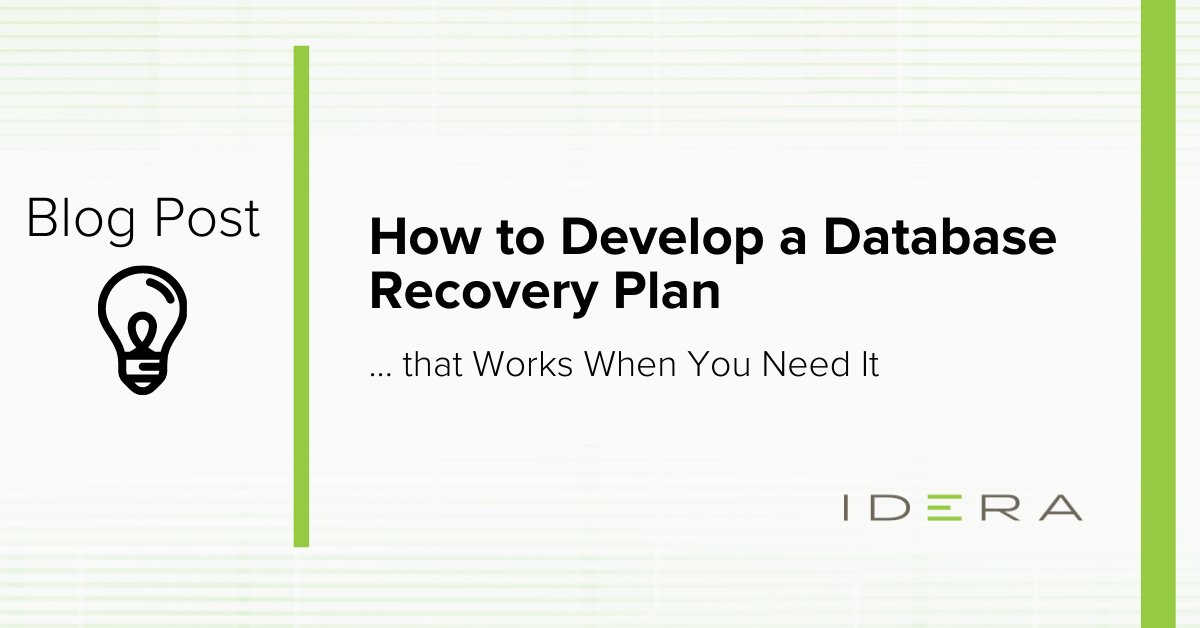Considering the value of data to the modern enterprise, developing a database recovery plan is crucial.
The majority of SQL Server database administrators (DBAs) are well aware of the importance of backing up their systems.
They need to ensure that the nightly, weekly, and monthly backups are running successfully to protect the enterprise data resources that inhabit their databases.
Repeated backup failures won’t be tolerated by management as it exposes the organization to data loss in the event of a disaster.
Backups are a critically important component of a viable SQL Server environment. But backups are useless unless they can be used to successfully recover the systems they are intended to protect.
There’s no worse feeling than having to report to upper management that you can’t recover the organization’s databases despite having backups on hand. To avoid the aftermath of a failed recovery and the potential negative ramifications to your professional career, DBAs need to have a verified disaster recovery plan.
What is a Disaster/Database Recovery Plan?
A disaster or database recovery plan is a document that an organization uses to define the necessary steps required to react to a manmade or natural disaster and quickly recover affected systems.
The disaster recovery plan focuses on minimizing downtime and restoring business-critical infrastructure components and applications promptly.
The following components go into the creation of a viable disaster recovery plan for databases.
- Recovery goals – The plan needs to define two important recovery elements. The Recovery Point Objective (RPO) represents the amount of data loss that can be tolerated by the organization. The Recovery Time Objective (RTO) describes the maximum allowable downtime for a critical system.
- Essential personnel – The technical resources that will perform the tasks related to the recovery need to be specified along with contact information.
- Inventory of IT assets – All hardware and software assets should be inventoried. The results of the inventory are then analyzed to determine the order in which systems will be recovered. Test and development systems may be left out of the early parts of the recovery plan.
- Review backup procedures – Backup procedures need to be reviewed to verify that all systems are being backed up successfully. Instructions on how to recover the backups should also be included.
- Disaster response procedures – This part of the plan outlines steps to be taken when there is time to react to a pending disaster. It may include special backups and defenses to thwart a cyberattack.
- List disaster recovery sites – Some organizations have multiple disaster recovery options. A hot site can be used to quickly replace the impacted infrastructure. In other cases, teams will need to travel to a disaster recovery site and recover systems from backup media.
- Recovery procedures – Detailed recovery procedures need to be documented for all systems that have been identified as recoverable based on the asset inventory.
The only way to satisfactorily verify a disaster recovery plan is through extensive testing.
Some organizations conduct periodic testing on a regular schedule. Others use a more ad-hoc approach where individual teams are responsible for testing their portion of the recovery.
Prioritizing System Recovery
In a large and complex computing environment, not all systems can be recovered simultaneously. This is due to the limited technical resources and may also be affected by physical constraints like the number of tape drives available for recovering from backup media.
Customer-facing systems whose downtime impacts the company’s bottom line need to be prioritized for recovery. Recovering these systems first minimizes the financial effects on the organization.
In many cases, there are SQL Server databases attached to these business-critical systems. DBAs are often under significant pressure in a disaster recovery scenario to get things running as soon as possible.
A Versatile SQL Server Backup and Recovery Tool
SQL Safe Backup is a flexible SQL Server backup and recovery tool that addresses the needs and concerns of DBAs attempting to recover critical systems quickly.
It offers multiple recovery options that allow teams to minimize downtime and any customer impact when a disaster strikes.
DBAs responsible for recovering from a disaster have multiple recovery techniques from which to choose.
- Teams can restore databases instantly to eliminate downtime. Data can be streamed on-demand from backup files to handle user requests and applications with the complete restoration executing in the background.
- Point-in-time recovery is easily selected using a graphical sliding time scale that will automatically gather all backup components required to recover a database to the specified time.
- Conventional and advanced restore capabilities are built into SQL Safe Backup that provide DBAs a greater degree of flexibility when recovering from a disaster.
SQL Safe Backup can be used with on-premises, cloud, and virtual SQL Servers. It furnishes a database team with a powerful tool to enact the disaster recovery procedures required to protect enterprise data assets.
The combination of a versatile recovery tool like SQL Safe Backup and a verified disaster recovery plan is essential to keep an organization protected when there are unexpected outages.
